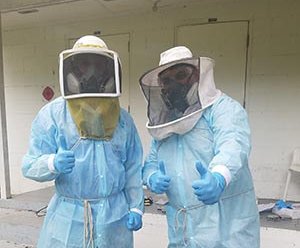
Perhaps it’s the wrong time of year to be writing about oxalic acid (OA). Most beekeepers apply this treatment in late fall or winter when brood is absent from colonies. But brood gaps can occur in mid-summer, especially if you’re creating those brood gaps as part of an Integrated Pest Management (IPM) varroa control strategy. Alternatively, some beekeepers ignore the brood gap recommendation and apply OA when brood is present in their colonies. And some beekeepers might be interested in brood interruption without OA. If you fall into any of those categories, read on. Or, if you’re only interested in applying OA later when your queens have stopped laying, just tuck this article away until the first wisp of crisp autumn air descends on your apiary.
Oxalic acid has been around as a varroa control strategy for several decades. This treatment is potentially very promising since there are no reports of mite resistance to date. But despite its promise and relatively lengthy history, OA was only registered for use against varroa in the United States in 2015. Thus, it’s a relatively new treatment option for most U.S. beekeepers, and because of this, there’s still a lot of debate about OA. Is OA vaporization effective against varroa when brood is or isn’t present? Is it most effective when used once or multiple times over a few weeks? Is caging your queen and creating a brood gap just as effective as OA vaporization for controlling varroa? And what about the bees — how stressful on your colonies is OA vaporization and/or caging your queens? These are the topics for our thirtieth “Notes from the Lab,” where we highlight “Evaluating the efficacy of oxalic acid vaporization and brood interruption in controlling the honey bee pest Varroa destructor (Acari: Varroidae),” written by Cameron Jack and colleagues and published in the Journal of Economic Entomology [113:582-588 (2020)].
For their study, Jack and colleagues assigned 10 colonies to each of seven treatments, creating an impressive array of experimental groups among 70 colonies. All colonies were managed such that they were similar in strength, composition, and mite loads at the beginning of the experiment. The treatments were: 1) OA vaporization applied once, 2) OA vaporization applied three times over three weeks, 3) brood interruption for 24 days, 4) OA applied once + brood interruption, 5) OA applied three times + brood interruption, 6) no OA or brood interruption as a negative control, and 7) treatment with amitraz (Apivar) as a positive control.
Each application of OA was comprised of 1 g OA powder (label rate) vaporized through the hive entrance on the bottom board. Brood interruption was conducted by isolating a colony’s queen in a queen cage within the hive for 24 days. Brood interruption occurred between day 0 and 24 for all treatments that included brood interruption, the 3x OA treatments occurred on days 8, 16, and 24, and the single OA application occurred on day 24. Finally, amitraz treatment was conducted by placing Apivar strips in the colonies for the first 35 days of the experiment. The authors conducted the experiment during September and October in Florida, meaning brood was present in the colonies throughout the experiment (except for the brood interruption treatments, of course).
The authors monitored three main outcomes during and after the experiment. First, varroa levels were determined by placing sticky boards in the bottom of each hive for 72 hours. Varroa levels were assessed before the experiment started (day -4), when treatments were applied (day 0), midway through the experiment (days 8, 16, 24, 31, and 35), and at the end of the experiment (day 62). Second, colony strength was assessed by measuring the quantity of bees, brood, honey, and ….


